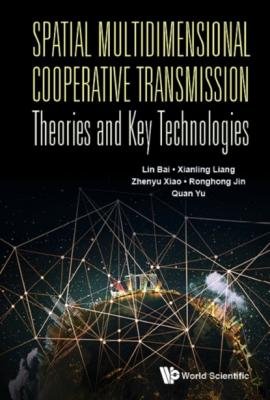Spatial Multidimensional Cooperative Transmission Theories And Key Technologies. Lin Bai
Читать онлайн.| Название | Spatial Multidimensional Cooperative Transmission Theories And Key Technologies |
|---|---|
| Автор произведения | Lin Bai |
| Жанр | Зарубежная компьютерная литература |
| Серия | |
| Издательство | Зарубежная компьютерная литература |
| Год выпуска | 0 |
| isbn | 9789811202476 |
SPATIAL MULTIDIMENSIONAL
COOPERATIVE TRANSMISSION
Theories and Key Technologies
Lin Bai
Beihang University, China
Xianling Liang
Shanghai Jiao Tong University, China
Zhenyu Xiao
Beihang University, China
Ronghong Jin
Shanghai Jiao Tong University, China
Quan Yu
Chinese Academy of Engineering, China
Published by
World Scientific Publishing Co. Pte. Ltd.
5 Toh Tuck Link, Singapore 596224
USA office: 27 Warren Street, Suite 401-402, Hackensack, NJ 07601
UK office: 57 Shelton Street, Covent Garden, London WC2H 9HE
Library of Congress Cataloging-in-Publication Data
Names: Bai, Lin (Associate professor), author. | Liang, Xianling, author. | Xiao, Zhenyu, author. | Jin, Ronghong, author. | Yu, Quan (Engineer), author.
Title: Spatial multidimensional cooperative transmission : theories and key technologies / Lin Bai, Beihang University, China, Xianling Liang, Shanghai Jiao Tong University, China, Zhenyu Xiao, Beihang University, China, Ronghong Jin, Shanghai Jiao Tong University, China, Quan Yu, Chinese Academy of Engineering, China.
Description: Singapore ; Hackensack, NJ : World Scientific, [2020] | Includes index.
Identifiers: LCCN 2020013219 | ISBN 9789811202452 (hardcover) | ISBN 9789811202469 (ebook) ISBN 9789811202476 (ebook other)
Subjects: LCSH: Radio--Transmitters and transmission. | Antenna arrays. | MIMO systems. | Cell phone systems.
Classification: LCC TK6561 .B27 2020 | DDC 621.382/4--dc23
LC record available at https://lccn.loc.gov/2020013219
British Library Cataloguing-in-Publication Data
A catalogue record for this book is available from the British Library.
Originally published in China by Posts & Telecom Press
Copyright © Posts & Telecom Press 2016
Copyright © 2020 by World Scientific Publishing Co. Pte. Ltd.
All rights reserved. This book, or parts thereof, may not be reproduced in any form or by any means, electronic or mechanical, including photocopying, recording or any information storage and retrieval system now known or to be invented, without written permission from the publisher.
For photocopying of material in this volume, please pay a copying fee through the Copyright Clearance Center, Inc., 222 Rosewood Drive, Danvers, MA 01923, USA. In this case permission to photocopy is not required from the publisher.
For any available supplementary material, please visit
https://www.worldscientific.com/worldscibooks/10.1142/11336#t=suppl
Desk Editors: Ramya Gangadharan/Yu Shan Tay
Typeset by Stallion Press
Email: [email protected]
Printed in Singapore
Preface
The development of mobile communication technology has witnessed mainly four generations so far. The first generation of mobile terminals that appeared in 1995 could only be used for voice communication. And the second generation of mobile terminals that were in use between 1996 and 1997 appeared with the addition of data transmitting and receiving functions, such as sending and receiving e-mails or web browsing. With the rapid development of communication and computer technology, Internet access service was introduced from the third generation of mobile communication, and then the mobile communication service entered a rapid development period of mobile Internet dominated by data services. Furthermore, the fourth generation of mobile communication reflected the demand for Internet-like communication services based on high-speed data streams. CCID data showed that by June 2012, the number of mobile Internet users had exceeded the number of computer users for the first time. Mobile Internet is changing the social interaction lifestyle of people as never before, and it has become one of the necessary means for modern human information interaction.
Faced with the growing demand for broadband communication and the rapid development of mobile Internet industry, how to realize large-capacity data transmission at anytime and anywhere has become an important issue in wireless communication. According to Shannon’s theory, the demand for wireless spectrum resources has also increased correspondingly, thus leading to the shortage of spectrum resources suitable for wireless communication. It has become the main bottleneck restricting the development of wireless communication. From the first generation to the third generation, the core technologies of mobile communication are FDMA, TDMA, and CDMA, respectively, which use resources such as frequency, time, and code element to improve the spectrum efficiency of the system. When people try to take full use of time, frequency, and code resources to improve spectrum utilization, the rational use of space resources and the development of the corresponding multi-antenna technology will become the core issues and key technologies of mobile communication in the future.
At the same time, with the continuous improvement of aerospace technology and the rapid growth of the types and quantities of space-based and air-based platforms, the space–air–ground-integrated information network consisting of satellites, stratospheric balloons and various aerospace vehicles is developing rapidly. The resulting space–air–ground-integrated mobile Internet will become an information bridge for human beings to understand space, enter space, use space, and develop space in the future. The rational use of the multi-antenna technology to realize efficient spatial multidimensional signal cooperative transmission is the premise of healthy development of the future space–air–ground-integrated mobile Internet and also provides theoretical basis and technical support for its development. Based on the principle of spatial multidimensional signal transmission and multi-antenna system, this book, respectively, introduces how to maximize the use of spatial dimension resources to improve system performance and spectral efficiency in ground-based, air-based, and space-based cooperative transmission systems.
In the first chapter, the book outlines the history of mobile communication and the characteristics of ground-based, air-based, and space-based cooperative communication systems. And then in the first part, the multi-antenna system and the key technologies of signal transmission and reception are discussed. Focusing on these issues, the vector space and multi-antenna system, adaptive system, MIMO multi-antenna system, and spatial multidimensional signal reception and iterative processing technologies are introduced in Chapters 2–5. Based on the above theories and technologies, the application and the corresponding key technologies of spatial multidimensional cooperative transmission in ground-based, air-based, and space-based
